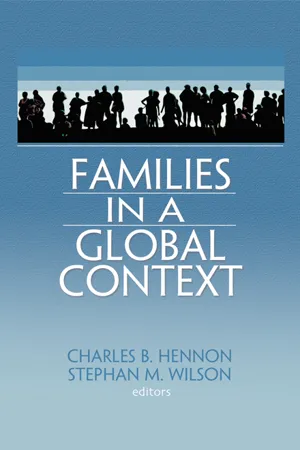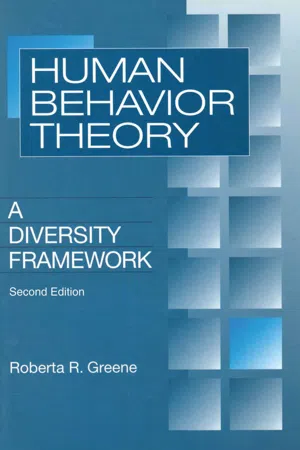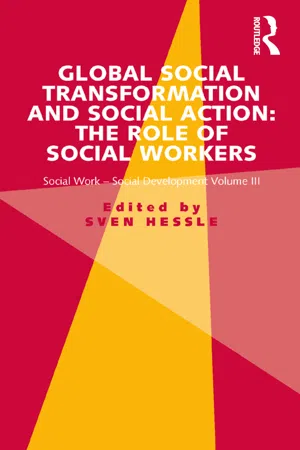Social Sciences
Families Around the World
"Families Around the World" is a study of the diverse structures and dynamics of families across different cultures and societies. It explores variations in family composition, roles, and traditions, shedding light on the impact of cultural, economic, and social factors on family life. This research provides valuable insights into the complexities and nuances of family systems worldwide.
Written by Perlego with AI-assistance
Related key terms
6 Key excerpts on "Families Around the World"
- eBook - ePub
- Charles B. Hennon, Stephan M. Wilson(Authors)
- 2011(Publication Date)
- Routledge(Publisher)
This book takes the perspective that globally, some aspects of human behavior are more commonly practiced and thus recognizable and understandable. However, culture shapes many behaviors. Culture refers to what a particular collective of people share in common and distinguishes them from other collectives or cultures. Culture encompasses both an abstraction (underlying values and assumptions) and a lived (specific behavior derived from values and assumptions) aspect. One is observable and one is not. Specific behaviors shared by a cultural group are not arbitrary; they are consistent with what the people of that culture value and believe. Without understanding the abstract values and worldviews, behavior is often misunderstood. Understanding the basis of behavior allows for not being surprised, avoiding a cultural faux pas, operating within the context of this culture, and conducting better research. It does not mean one has to like or accept the behavior or the values.Another dimension of human behavior is the personal. This is how each person or family is unique from each other even within the same culture. Not everyone sharing a culture thinks, values, or acts alike (Culture Matters, n.d.). There is a substantial amount of diversity in family life when considered from a global perspective. Understanding the differences among families within countries as well as across countries is becoming more important, both for serious students of the family and for enhancing global literacy. The situations that challenge each family and the strategies each family uses to meet its needs and achieve its goals vary widely. Each family is unique in this way, but within cultures and subcultures, and even across cultures, some more general patterns are observable.Readers of this book will notice that some societies appear to have a more homogenous family pattern than do others. Even while this might be true, given the space limitations, it is not possible to give equal weight to the within country diversity found in many nations. However, contributors do highlight important differences within their societies. For example, differences among ethnic groups in Kenya and Sierra Leone, blacks and whites in South Africa, and the indigenous peoples compared with more recent immigrants in Australia.2All societies recognize families. However, what is family is often debated. In this book, family is often regarded as an analytical concept or as a socially constructed object (Gubrium & Holstein, 1990 ). As Gubrium and Holstein (1990 , p. 13) stated, “The term ‘family’ is part of a particular discourse for describing human relations in or out of the household.” Family life emerges from commonplace interactions and communications with others. These lead to the understanding of family in terms of relationships acknowledged by the participants as family within a certain cultural context. Even within the more hegemonic forces of a culture indicating what a family “should be,” there will be variations. For example, in the United States, a same-sex couple with children does not fit the standard legal and often moral conceptualization of family. Yet, the people in these relationships consider their relationships and interdependencies as being “their family.” The same can be true of polygamous families living in the western United States. The practice of gynaegamy among the Kisii in Kenya is another example that is discussed in this book. Distinct from lesbian couples, in this practice an older woman assumes the responsibilities of a “husband and father,” adopts the children of the younger woman, and provides for the family. If the younger woman has no children, arrangements are made for a “sperm donor” from among close relatives of the older woman (Wilson, Ngige, & Trollinger, 2003 - eBook - ePub
Human Behavior Theory
A Diversity Framework
- Roberta Greene(Author)
- 2017(Publication Date)
- Routledge(Publisher)
The family therapy field is highly abstract and insufficiently self critical (Weiner & Boss, 1985). Failure to be self-critical, according to Bernai and Ysern (1986), has led to the implicit acceptance of several social and pol iti-cal assumptions about the nature of U.S. society, including the structures of injustice and the way such exploitation harms families and the “normative endorsement of the nuclear family and its traditional sex roles” (p. 131). In this vein, the following section outlines key systems concepts and discusses how these concepts have been applied to address diverse family forms.Culture and the Family
Ethnicity and family life are two concepts which . . . go hand in hand. They are so entwined that it is very difficult indeed to observe the one or even to reflect it seriously without coming to grips with the other.(Billingsley, 1976, p. 13)For social workers to provide culturally sensitive assessment and treatment for families with ethnic and cultural backgrounds different from their own, it is necessary to understand the cultural aspects of family systems (Tseng & Hsu, 1991). As family members interact with each other and the environment, they develop a set of shared meanings that serve as a social foundation for their culture (Chess & Norlin, 1988). Culture refers to a group’s way of life: those elements of a people’s history, tradition, values, and social organization that become implicitly or explicitly meaningful to the participants (Green, 1982).The family is often viewed as the basic sociocultural institution through which culture is transmitted. Culture is said to shape the cycle of growth of family systems members as well as the group’s culture. Within the contexts of its members, the family maintains itself throughout its life by adhering to its own values and beliefs (Kluckhorn, 1951). Culture, then, is “the symbolic image of [a family’s] purpose that its members carry around in their heads” (Polsky, 1969, p. 12). - eBook - ePub
The Social Self and Everyday Life
Understanding the World Through Symbolic Interactionism
- Kathy Charmaz, Scott R. Harris, Leslie Irvine(Authors)
- 2018(Publication Date)
- Wiley-Blackwell(Publisher)
1998 ). These advocates see variations and deviations from SNAF as weaker imitations or flawed substitutes for the real thing.As a second approach, many social scientists try to conceptualize family in a way that accurately reflects its diverse manifestations. These scholars ask: Given the variety of kinship systems in the U.S. and globally, can we define family in an inclusive and accurate way? For example, Schwartz and Scott (2007:3) conceptualize family as “any relatively stable group of people bound by ties of blood, marriage, adoption; or by any sexually expressive relationship; or who simply live together, and who are committed to and provide each other with economic and emotional support.” Cohen (2015:4) offers a more succinct option: “Families are groups of related people, bound by connections that are biological, legal, or emotional.” Such broad definitions are useful and capture a much wider range of kinship practices. Still, problems of exclusion remain. For example, what about pets? Our companion animals may not be “people,” but may be loved deeply, as evidenced by photographs, gifts, tombstones, and other indicators. Can't pets be integral members of families? (See the boxed excerpt on Donna; she considered her dog Athena to be the “love of her life,” more important than any spouse or romantic partner she ever knew.) On the other hand, another problem is that broad definitions may error by including too much. A group of college students might live together and provide each other with economic and emotional support but deny that they consider each other family. It depends.In light of these difficulties, symbolic interactionists offer a third approach to answering the question “What is family?” Instead of trying to settle the issue in advance, some researchers bracket (or set aside) the issue, to better investigate the diverse meanings that other people give to family in the course of their daily lives (Harris 2008 - eBook - ePub
Family, Self, and Human Development Across Cultures
Theory and Applications, Second Edition
- Cigdem Kagitcibasi(Author)
- 2007(Publication Date)
- Routledge(Publisher)
The three different family models are proposed as prototypes of family patterns that are prevalent in different societal contexts. To understand the different family models, however, we need to look into their basic shared structure. This structure constitutes a general framework that situates the family, family interaction, and socialization in its sociocultural context, thus linking self and family to the context. I discuss this general framework first before I go on into the three different models.In the general theoretical framework (Fig. 5.1 ), reflected also in the three specific models that follow, there is recognition of the primacy of the context in which the family is situated. The context is construed mainly in terms of the culture and the living conditions of the family and is seen as basically an influencing component. Culture is construed as mainly individualistic (culture of separateness) or as collectivist (culture of relatedness ), as I have discussed earlier. It refers to the existing culture base underlying the socioeconomic-structural factors and the family system. Urban—rural residence, socioeconomic development levels, and subsistence/affluence characteristics of the living conditions are taken up as significant indicators of context. However, they are not considered to be exhaustive.In this contextual framework, there is a systemic approach to the family. The subsystems of the family are socialization values and interaction patterns in childrearing and in self—other relations. Family structure can be seen both as the context of family functioning (affecting it) and also as a part of the family system, in general. Social change and societal development impact the family with resultant changes in the family structure and the family system. Such changes may, in turn, feed back into the context, modifying some of the living conditions. This kind of a feedback loop would occur mainly through changes in family structure. Thus, a dynamic interaction takes place between the context and the family system through time. - eBook - ePub
- Gerald Handel(Author)
- 2018(Publication Date)
- Routledge(Publisher)
A major contributor to family culture is the subculture or stratum to which it belongs. All societies are stratified with inequality occurring between certain subgroups in regard to power, prestige, and privilege. For some dimensions (e.g., gender and generation) different unequal subgroups are found within the same family and for other dimensions (e.g., social class, ethnicity, and community of residence) a family’s members will all belong to the same subgroup or stratum. A family’s gender and generation distribution results in compositional differences. A family’s social class, ethnicity, and community provide its social address or coordinates, locating it in the social structure according to their particular strata (Berger, 1963). The latter dimensions are crucial as society’s most significant subcultures represent particular social classes, ethnic groups and communities. Specific subcultures often involve overlapping subgroups from different dimensions, for example the culture of poverty attributed to many lower class, Black, innercity neighborhoods (Rainwater, 1970; Stack, 1974).If a middle-class, White family lives in the suburbs, this social address provides important information about its culture. If this household is headed by a divorced, middle-aged, single father who grew up during the counterculture of the 1960s, more insight is gained into its culture. The social context, as identified by its location on the inequality dimensions, contributes a great deal to a family’s culture. Major social coordinates provide detail about family norms and consequent behavior without focusing upon an individual family. This is true for many large subgroups of families who share the same social address in society.Family Microlevel Systems
Additional details on family culture come from the microlevel or analyzing the family as a primary group. This small intimate group, operating within and impinged upon by the larger social context, generates its own “culture” while performing its various tasks. This group does not appear to be as complex as the larger social structure yet in many ways it is. Compared to most other social groups (e.g., peers) it is much more heterogeneous. It is much more likely to contain persons representing different generations, genders, and backgrounds. More so than other social groups, the family is really a complicated, sometimes fragile, blending of human differences.The family’s organizational complexity is suggested in great detail by Kantor and Lehr’s (1975) analysis of its space, time, energy, and other essential dimensions. The intricacies result from the three distinct, yet interrelated, family subsystems. Dividing the family into systems of decreasing size, the three subsystems include the entire family unit, the interpersonal subsystems (e.g., the father-son dyad), and each personal subsystem. Each family member is a unique individual participant who is related in dyads to all fellow members and part of the whole group. A typical family of four would contain eight subsystems, that is, four personal ones, three dyadic ones, and one for the entire unit. The sometimes contradictory needs and responsibilities of these subsystems and their interdependence provides useful details on family functioning on a day-to-day basis. - eBook - ePub
Global Social Transformation and Social Action: The Role of Social Workers
Social Work-Social Development Volume III
- Sven Hessle(Author)
- 2016(Publication Date)
- Routledge(Publisher)
This part deals with the variation of family forms and family relations and how this can be understood in contemporary processes of globalisation. While it has been shown that the family as an institution varies between different welfare state and social policy contexts (e.g. Lewis 1992, Sainsbury 1994), it has also been questioned whether we can talk in general about the family as an institution. This questioning relies on observations of the destabilising of the family, among other things with regard to the increasing prevalence and recognition of same-sex and lone-parent families, but also changing expectations and experiences of the social roles of women and men, wives and husbands, (grand)mothers and (grand)fathers, and children (Stacey 1996, Morgan 1996, Silva and Smart 1999). In this study I contribute to this discussion by regarding how the family as an institution is being destabilised following on how contemporary processes of globalisation settle in everyday practices, processes that involve migration and the transnationalisation of everyday life. I approach the family in two different ways; as framed by norms and values embedded within particular welfare state and social policy settings on the one hand, and as framed by family practices on the other. Analytically, my focus is limited to relations between parents and small children and I argue that while the national frame is influential, transnational flows involve both the dispersal of certain expectations about the family across borders, and the de-standardisation of such expectations within countries.Methodology
The part reviews these two approaches to the family as they are manifest in cross-national comparisons and transnational studies of the family and then applies them to the Swedish case. While cross-national comparisons show how the family as an institution varies between different national social policy institutional settings, they also rely on assumptions about countries (sometimes regions) as bounded social entities. This kind of given assumption is questioned by the transnational approach that instead is sensitive to the construction of bordered and bounded entities as well as flows across these. The reviews are applied to the Swedish case by, first, a literature review of the development of the Swedish welfare state and social policy setting and its implications for the family as an institution (cf. part II in Righard 2008), and second, by a small sample empirical study conducted in Sweden about family relations and practices from a transnational approach (see Righard 2011). The arguments presented are theoretically driven and the literature review and empirical excerpts are presented to illustrate the argument. As a contribution to the methodological development, I suggest an analytical focus on the doing of biographies and family practices as a way to integrate more macro-oriented with micro-level empirical analysis (see Righard 2008, forthcoming).
Learn about this page
Index pages curate the most relevant extracts from our library of academic textbooks. They’ve been created using an in-house natural language model (NLM), each adding context and meaning to key research topics.





